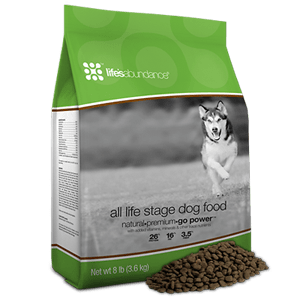
DogFoodAdvisor is reader supported See how
All reviews are 100% impartial but if you buy using links on this page, we may earn a referral fee.
Our Verdict
Life’s Abundance product range is made up of six recipes with ratings varying from 4.5 to 5 stars. The average rating of the whole range is 5 stars.
The table below shows each recipe in this range including our rating and the AAFCO nutrient profile: Growth (puppy), Maintenance (adult), All Life Stages, Supplemental or Unspecified.
| Product line | Rating | AAFCO |
|---|---|---|
| Life's Abundance Lamb Meal and Brown Rice | 5 | A |
| Life's Abundance All Life Stage | 5 | A |
| Life’s Abundance Grain-Free All Life Stage | 5 | A |
| Life’s Abundance Small and Medium Breed Puppy | 5 | A |
| Life’s Abundance Large Breed Puppy Food | 4.5 | A |
| Life's Abundance Adult Weight Loss | 5 | M |
Recipe and Label Analysis
Life’s Abundance All Life Stage Dog Food was selected to represent the other products in the line for detailed recipe and nutrient analysis.
Life's Abundance All Life Stage
Estimated Dry Matter Nutrient Content
Protein
Fat
CarbsCarbohydrates
Chicken meal, ground brown rice, oat groats, chicken fat (preserved with mixed tocopherols), egg product, pearled barley, dried beet pulp, flaxseed meal, ground miscanthus grass, yeast culture, fish oil, dried tomato pomace, natural flavor, whitefish meal, potassium chloride, sunflower lecithin, dicalcium phosphate, salt, inulin, yeast extract, dl-methionine, choline chloride, l-lysine, l-ascorbyl-2-polyphosphate (source of vitamin C), vitamin E supplement, taurine, broccoli, spinach, pumpkin, blueberries, cranberries, zinc sulfate, ferrous sulfate, zinc proteinate, iron proteinate, pomegranate extract, selenium yeast, copper proteinate, inositol, niacin supplement, thiamine mononitrate, d-calcium pantothenate, vitamin A acetate, manganese sulfate, riboflavin supplement, pyridoxine hydrochloride, biotin, manganese proteinate, vitamin B12 supplement, vitamin D3 supplement, calcium iodate, folic acid, dried lactobacillus casei fermentation product, dried lactobacillus acidophilus fermentation product, dried bifidobacterium animalis fermentation product, dried lactobacillus reuteri fermentation product
Fiber (estimated dry matter content) = 5%
Red denotes any controversial items
| Estimated Nutrient Content | |||
|---|---|---|---|
| Method | Protein | Fat | Carbs |
| Guaranteed Analysis | 26% | 16% | NA |
| Dry Matter Basis | 29% | 18% | 45% |
| Calorie Weighted Basis | 25% | 37% | 39% |
Ingredients Analysis
The first ingredient in this dog food is chicken meal. Chicken meal is considered a meat concentrate and contains nearly 300% more protein than fresh chicken.
The second ingredient is ground brown rice, another name for rice flour. Ground rice is made from either white or brown rice and is considered a gluten-free substitute for wheat flour.
The third ingredient includes oat groats, a whole grain, minimally processed form of oats. With the exception of their caloric content and the fact they’re also gluten free, oat groats can be considered average in nutritional value.
The fourth ingredient is chicken fat. This item is obtained from rendering chicken, a process similar to making soup in which the fat itself is skimmed from the surface of the liquid.
Chicken fat is high in linoleic acid, an omega-6 fatty acid essential for life. Although it doesn’t sound very appetizing, chicken fat is actually a quality ingredient.
The fifth ingredient is egg product, an unspecified (wet or dry?) form of shell-free eggs. Quality can vary significantly. Lower grade egg product can even come from commercial hatcheries — from eggs that have failed to hatch.
In any case, eggs are easy to digest and have an exceptionally high biological value.
The sixth ingredient is barley. Barley is a starchy carbohydrate supplying fiber and other healthy nutrients. However, aside from its energy content, this cereal grain is of only modest nutritional value to a dog.
The seventh ingredient is beet pulp. Beet pulp is a controversial ingredient, a high fiber by-product of sugar beet processing.
Some denounce beet pulp as an inexpensive filler while others cite its outstanding intestinal health and blood sugar benefits.
We only call your attention here to the controversy and believe the inclusion of beet pulp in reasonable amounts in most dog foods is entirely acceptable.
The eighth ingredient is flaxseed meal, one of the best plant-based sources of healthy omega-3 fatty acids. Flax meal is particularly rich in soluble fiber.
However, flaxseed contains about 19% protein, a factor that must be considered when judging the actual meat content of this dog food.
From here, the list goes on to include a number of other items.
But to be realistic, ingredients located this far down the list (other than nutritional supplements) are not likely to affect the overall rating of this product.
With seven notable exceptions…
First, we find fish oil. Fish oil is naturally rich in the prized EPA and DHA type of omega-3 fatty acids. These two high quality fats boast the highest bio-availability to dogs and humans.
Depending on its level of freshness and purity, fish oil should be considered a commendable addition.
Next, tomato pomace is a controversial ingredient, a by-product remaining after processing tomatoes into juice, soup and ketchup.
Many praise tomato pomace for its high fiber and nutrient content, while others scorn it as an inexpensive pet food filler.
Just the same, there’s probably not enough tomato pomace here to make much of a difference.
In addition, we note the inclusion of inulin, a starch-like compound made up of repeating units of carbohydrates and typically sourced from chicory root.
Not only is inulin a natural source of soluble dietary fiber, it’s also a prebiotic used to promote the growth of healthy bacteria in a dog’s digestive tract.
We also find yeast extract, which is the common name for a broad group of products made by removing the cell wall from the yeast organism.
A significant number of these ingredients are added as specialized nutritional supplements while others are used as flavor enhancers.
However, the glutamic acid (and its chemical cousin, monosodium glutamate, or MSG) found in a minority of yeast extracts can be controversial.
That’s because even though the Food and Drug Administration designated these food additives to be safe decades ago, the agency continues to receive reports of adverse effects.
So, detractors still object to the use of yeast extract and other glutamic acid derivatives and blame them for everything from Alzheimer’s (in humans) to obesity.
In any case, since the label reveals little about the actual type of yeast extract included in any recipe, it’s impossible for us to judge the quality of this ingredient.
Next, this food includes chelated minerals, minerals that have been chemically attached to protein. This makes them easier to absorb. Chelated minerals are usually found in better dog foods.
Additionally, we note the use of taurine, an important amino acid associated with the healthy function of heart muscle. Although taurine is not typically considered essential in canines, some dogs have been shown to be deficient in this critical nutrient.
Since taurine deficiency appears to be more common in pets consuming grain-free diets, we view its presence in this recipe as a positive addition.
And lastly, this recipe contains selenium yeast. Unlike the more common inorganic form of selenium (sodium selenite), this natural yeast supplement is considered a safer anti-cancer alternative.
Nutrient Analysis
Based on its ingredients alone, Life’s Abundance Dog Food looks like an above-average dry product.
The dashboard displays a dry matter protein reading of 29%, a fat level of 18% and estimated carbohydrates of about 45%.
As a group, the brand features an average protein content of 30% and a mean fat level of 17%. Together, these figures suggest a carbohydrate content of 44% for the overall product line.
And a fat-to-protein ratio of about 57%.
Above-average protein. Near-average fat. And below-average carbs when compared to a typical dry dog food.
Even when you consider the protein-boosting effect of the flaxseed meal, this looks like the profile of a kibble containing a significant amount of meat.
Life's Abundance Dog Food Recall History
The following automated list (if present) includes all dog food recalls related to Life's Abundance through December 2025.
No recalls noted.
You can view a complete list of all dog food recalls since 2009 here.
Our Rating of Life's Abundance Dog Food
Life’s Abundance includes both grain-inclusive and grain-free dry dog foods using a significant amount of named meat meals as its dominant source of animal protein, thus earning the brand 5 stars.
Compare Life's Abundance Dog Food
How does Life's Abundance compare with The Dog Food Advisor's most recommended brands?
A Final Word
The Dog Food Advisor does not accept money, gifts, samples or other incentives in exchange for special consideration in preparing our reviews.
However, we do receive a referral fee from online retailers (like Chewy or Amazon) and from sellers of perishable pet food when readers click over to their websites from ours. This helps cover the cost of operation of our free blog. Thanks for your support.
For more information, please visit our Disclaimer and Disclosure page.







